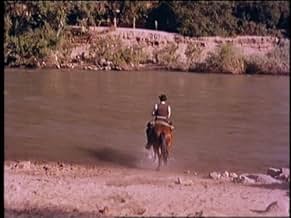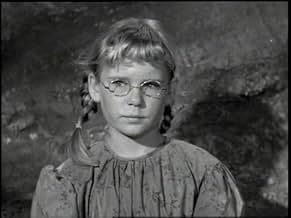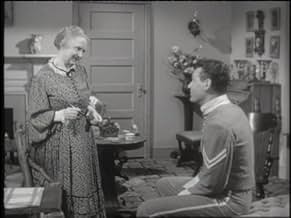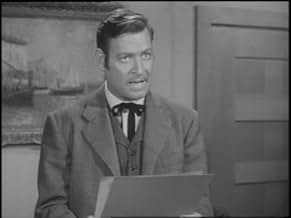The adventures of the masked Texas Ranger and his Native American partner.The adventures of the masked Texas Ranger and his Native American partner.The adventures of the masked Texas Ranger and his Native American partner.
- Nominated for 2 Primetime Emmys
- 3 nominations total
Browse episodes
Featured reviews
Iam not sure if discussing the television series is exactly where the comments should be drawn to,however it is on the television where the The Lone Ranger really made a name for himself. Iam not even referring to the original radio broadcasts of this masked rider of the plains,Iam though referring to a point where in a little boy, about 9 or 10 years old,I was to see the movie,"The Lone Ranger"and never forgot it. I can recall that I was on a line or we were moving toward the Paramount Theater-the theater was located in the theater district,if I remember correctly. It was directly across,going East to West from the building that has the ball that drops on New Years Eve-This is of course if anybody doesn't know, New York City. High Above the street on the roof tops there was a time and maybe even still today huge billboards would advertise what was being shown and so on. It was at that point in time that I looked up and was never more impressed as I was when I looked at that billboard to see The Lone Ranger across the roof tops-It was great-It made an impression and was never forgotten. That day we went to see The Lone Ranger-It was the story of how the Lone Ranger was born-The terrible ambush that the Texas Rangers rode into and the subsequent rebirth of one of its fallen heroes. It was in this film we learn that The Lone Ranger will not shoot to kill but to injure so as to let the law be the judge. That type of thinking is so worthwhile that we might be good to learn something from history. This is where we learn that Tonto discovers the fallen Ranger and upon seeing the symbol of the boyhood friendship that The Lone Ranger established years earlier when he as a younger person came to the aide of a injured young person in Tonto-For the aide given, Tonto gave to his faithful friend, a symbol of his thanks which now was part of a necklace that Tonto recognized. Tonto said,"you are Kemosabe". The Lone Ranger said,"kemo-sabe,that is familiar? Then Tonto tells the story of this "trusty scout"(the meaning of Kemosabe)I think the Lone Ranger is one of the true heroes of the silver screen and one of the great heroes of television. It should also be stated that these very respected individuals Clayton Moore and Jay Silverheels sought to live there lives according to the legend of The Lone Ranger-It may very well be that there is an inspiring story in the story of the Lone Ranger and his faithful companion Tonto. I myself was so pleased by the ability to find and buy the DVDs, that I stayed up all a Saturday morning and watched The many episodes now available. Long Live The Lone Ranger and His faithful companion Tonto-Hi-Ho Silver-
The 221 episodes of "The Lone Ranger" were originally broadcast on ABC from 1949 to 1957; and then for many years they played in local syndication. For most of the original broadcast years the series was ABC's most watched piece of programming.
The new DVD set from Pop Flix contains the first 16 episodes (15 Sept-29 Dec 1949) and for some reason unknown to me episode 22 from the fifth season, for a total of 17 episodes (the same 17 available on last year's Mill Creek Entertainment release so these are probably in the public domain). These sets pretty much render "The Legend of the Lone Ranger" movie superfluous as all three episodes that were combined in 1952 to form the movie are included in these releases.
The early episodes hark back to radio as there is considerably more voice-over narration used as an introduction and to introduce key plot moments.
The series itself was pure kiddie western with clear-cut good and evil distinctions and no romance. The title character (played by Clayton Moore) started out Texas Ranger John Reid. The first three episodes provide the background for his transformation to Lone Ranger status, his partnering with the Indian Tonto (Jay Silverheels), and the taming of his horse "Silver".
There is an unambiguous code of positive morality infusing each episode. The Lone Ranger is totally good but he adopts the guise of evil. While a masked man in the west was normally feared by the good citizens and an Indian was distrusted, the Lone Ranger is feared by those who would do evil. One persistent theme is that when the Lone Ranger and Tonto first encounter an average citizen they are greeted with suspicion, and by the end of the episode the citizen has been convinced of their value. The trademark ending was a secondary character asking the question: "who was that masked man?".
To really enjoy the series you must accept it for the simplistic morality tale it was intended to be. If you don't take it seriously and keep wishing for some self-reflexive campy parody elements you will only get frustrated.
Then again, what do I know? I'm only a child.
The new DVD set from Pop Flix contains the first 16 episodes (15 Sept-29 Dec 1949) and for some reason unknown to me episode 22 from the fifth season, for a total of 17 episodes (the same 17 available on last year's Mill Creek Entertainment release so these are probably in the public domain). These sets pretty much render "The Legend of the Lone Ranger" movie superfluous as all three episodes that were combined in 1952 to form the movie are included in these releases.
The early episodes hark back to radio as there is considerably more voice-over narration used as an introduction and to introduce key plot moments.
The series itself was pure kiddie western with clear-cut good and evil distinctions and no romance. The title character (played by Clayton Moore) started out Texas Ranger John Reid. The first three episodes provide the background for his transformation to Lone Ranger status, his partnering with the Indian Tonto (Jay Silverheels), and the taming of his horse "Silver".
There is an unambiguous code of positive morality infusing each episode. The Lone Ranger is totally good but he adopts the guise of evil. While a masked man in the west was normally feared by the good citizens and an Indian was distrusted, the Lone Ranger is feared by those who would do evil. One persistent theme is that when the Lone Ranger and Tonto first encounter an average citizen they are greeted with suspicion, and by the end of the episode the citizen has been convinced of their value. The trademark ending was a secondary character asking the question: "who was that masked man?".
To really enjoy the series you must accept it for the simplistic morality tale it was intended to be. If you don't take it seriously and keep wishing for some self-reflexive campy parody elements you will only get frustrated.
Then again, what do I know? I'm only a child.
Return with me now to those thrilling days of yesteryear.....
There can be no denying that The Lone Ranger is the quintessential TV Western of the 1950s. It is the one show that has proved, time and again, to be a real favorite of both children and adults alike.
Starring Clayton Moore, as the masked rider, and Jay Silverheels, as Tonto, his ever-loyal sidekick, The Lone Ranger was an action-packed, half-hour program whose episodes always had an interesting and thoughtful story to tell about life in the days of the Old West.
Actor Clayton Moore was the absolute embodiment of this mysterious, masked crime-fighter who would often go to great lengths to see that justice was done and that the criminals paid a dear price for their dishonest deeds.
Clayton Moore was once quoted as saying that he had "fallen in love with being the Lone Ranger character".
The Lone Ranger's story concerns a nameless Texas Ranger who is the sole survivor of a vicious ambush. After he is nursed back to health by his new-found comrade, Tonto, he embarks on a mission to bring justice and peace to the lawlessness of the Old West.
Using the benefits from a secret silver mine, the Lone Ranger rides the West on his magnificent horse, Silver, and dispenses justice in the form of his trademark - The silver bullet.
Following the cancellation of The Lone Ranger in 1957, Clayton Moore then embarked on a 40-year career making personal appearances, TV guest spots, and classic TV commercials dressed up as the legendary masked man.
In 1999 Moore died of a heart attack. He was 85 years old.
There can be no denying that The Lone Ranger is the quintessential TV Western of the 1950s. It is the one show that has proved, time and again, to be a real favorite of both children and adults alike.
Starring Clayton Moore, as the masked rider, and Jay Silverheels, as Tonto, his ever-loyal sidekick, The Lone Ranger was an action-packed, half-hour program whose episodes always had an interesting and thoughtful story to tell about life in the days of the Old West.
Actor Clayton Moore was the absolute embodiment of this mysterious, masked crime-fighter who would often go to great lengths to see that justice was done and that the criminals paid a dear price for their dishonest deeds.
Clayton Moore was once quoted as saying that he had "fallen in love with being the Lone Ranger character".
The Lone Ranger's story concerns a nameless Texas Ranger who is the sole survivor of a vicious ambush. After he is nursed back to health by his new-found comrade, Tonto, he embarks on a mission to bring justice and peace to the lawlessness of the Old West.
Using the benefits from a secret silver mine, the Lone Ranger rides the West on his magnificent horse, Silver, and dispenses justice in the form of his trademark - The silver bullet.
Following the cancellation of The Lone Ranger in 1957, Clayton Moore then embarked on a 40-year career making personal appearances, TV guest spots, and classic TV commercials dressed up as the legendary masked man.
In 1999 Moore died of a heart attack. He was 85 years old.
The Lone Ranger appeared on the ABC network on September 15, 1949 in the first of a three part episode that told the history of the famous masked man of the West.
Along with William Boyd's Hopalong Cassidy TV series, which was first telecast on NBC on June 24, 1949, it was among the earliest TV western series. Hopalong Cassidy actually debuted in 1948, when Boyd syndicated his films to NBC. (In 1947, Boyd had bought to the rights to his Hoppy films.)
Fran Stiker and George W. Trendle created the Lone Ranger as a local radio program in 1933. It quickly went nationwide and was the cornerstone of the old Mutual Radio network. Ironically, Hopalong Cassidy was also a Mutual radio program.
When The Lone Ranger was brought to TV in 1949, many of the radio plays were adapted to the younger medium. As a consequence, many of the earliest episodes show their radio origins with the use of a narrator who links the different scenes together. The Lone Ranger was the biggest hit on the new ABC network in its early years.
The first three episodes told the the familiar story of how the Lone Ranger came to be, his connection to Tonto, and the origins of his prize horse Silver. Glenn Strange played the villain Butch Cavandish in these episodes.
The Lone Ranger was also one of the earliest shows to film mostly outdoors. Starting in 1956, the Wrather Company began filming the program in color.
The Cisco Kid, starring Duncan Renaldo and Leo Carrillo had been filmed in color since its first aired in 1950. Jack Wrather, however, was more concerned about the competition to his kid's show from the new adult westerns that had began to appear on TV.
When the Lone Ranger appeared, The New York Times critic Jack Gould ripped the show, as "just another Western, and not a notably good one at that." Gould considered the first three episodes manipulative, mostly because of the cliffhanger endings of the first two episodes. The New York Times writer accused everyone associated with the program of keeping children "emotionally hopped upped." As a result of his criticisms, the cliffhanger type endings were never used after the first two episodes. Gould, however, had been suffering from a misunderstanding. The show had never intended to be broadcast as a serial despite the serial background of its star Clayton Moore.
In 1952, B-film actor John Hart replaced Clayton Moore. Moore had threatened to quit after 1950. He was being paid only $500 an episode for his hit show, and wanted a substantial raise. Audiences rejected Hart in the role, and after 36 episodes Moore was back atop Silver.
The Lone Ranger was the first Western Hit on TV.
The series was filmed in both Utah and in California.
Along with William Boyd's Hopalong Cassidy TV series, which was first telecast on NBC on June 24, 1949, it was among the earliest TV western series. Hopalong Cassidy actually debuted in 1948, when Boyd syndicated his films to NBC. (In 1947, Boyd had bought to the rights to his Hoppy films.)
Fran Stiker and George W. Trendle created the Lone Ranger as a local radio program in 1933. It quickly went nationwide and was the cornerstone of the old Mutual Radio network. Ironically, Hopalong Cassidy was also a Mutual radio program.
When The Lone Ranger was brought to TV in 1949, many of the radio plays were adapted to the younger medium. As a consequence, many of the earliest episodes show their radio origins with the use of a narrator who links the different scenes together. The Lone Ranger was the biggest hit on the new ABC network in its early years.
The first three episodes told the the familiar story of how the Lone Ranger came to be, his connection to Tonto, and the origins of his prize horse Silver. Glenn Strange played the villain Butch Cavandish in these episodes.
The Lone Ranger was also one of the earliest shows to film mostly outdoors. Starting in 1956, the Wrather Company began filming the program in color.
The Cisco Kid, starring Duncan Renaldo and Leo Carrillo had been filmed in color since its first aired in 1950. Jack Wrather, however, was more concerned about the competition to his kid's show from the new adult westerns that had began to appear on TV.
When the Lone Ranger appeared, The New York Times critic Jack Gould ripped the show, as "just another Western, and not a notably good one at that." Gould considered the first three episodes manipulative, mostly because of the cliffhanger endings of the first two episodes. The New York Times writer accused everyone associated with the program of keeping children "emotionally hopped upped." As a result of his criticisms, the cliffhanger type endings were never used after the first two episodes. Gould, however, had been suffering from a misunderstanding. The show had never intended to be broadcast as a serial despite the serial background of its star Clayton Moore.
In 1952, B-film actor John Hart replaced Clayton Moore. Moore had threatened to quit after 1950. He was being paid only $500 an episode for his hit show, and wanted a substantial raise. Audiences rejected Hart in the role, and after 36 episodes Moore was back atop Silver.
The Lone Ranger was the first Western Hit on TV.
The series was filmed in both Utah and in California.
Seriously, while I don't want to be unfair to John Hart, it's impossible for me to watch any of his episodes and not miss Clayton Moore, and I mean miss Clayton Moore badly. It's hard to believe that producer George Trendle really thought he could put anyone in the mask and the public wouldn't know the difference. And the difference was enormous. Clayton Moore played the Lone Ranger with great style and unquestionable sincerity. To me, Clayton Moore' Lone Ranger and William Boyd's Hopalong Cassidy were the best of the early television western heroes. They hold a special place in the hearts of many baby boomers, myself included.
Did you know
- TriviaThe Lone Ranger's young nephew, Dan Reid, who appeared occasionally on this show, was the father of Britt Reid, The Green Hornet. Both characters were created for radio by George W. Trendle.
- GoofsIn the series opening used in syndication, the Lone Ranger is seen riding past rows of trees planted as wind breaks. This practice did not come into use until after the "dust bowl" windstorms of the 1930s.
- Quotes
[first lines for each episode]
Narrator: The Lone Ranger!
[gunshots are fired]
The Lone Ranger: Hi-yo, Silver!
Narrator: A fiery horse with the speed of light, a cloud of dust and a hearty "Hi-yo Silver" - the Lone Ranger!
The Lone Ranger: Hi-yo, Silver, away!
Narrator: With his faithful Indian companion, Tonto, the daring and resourceful masked rider of the plains led the fight for law and order in the early West. Return with us now to those thrilling days of yesteryear. The Lone Ranger rides again!
- Alternate versionsThe first three episodes are available edited together as a ersatz feature "Enter the Lone Ranger" (1949) running 68 minutes minus titles and recaps.
- ConnectionsEdited into The Legend of the Lone Ranger (1952)
- SoundtracksWilliam Tell Overture: Finale
by Gioachino Rossini
- How many seasons does The Lone Ranger have?Powered by Alexa
Details
- Runtime30 minutes
- Aspect ratio
- 1.33 : 1
Contribute to this page
Suggest an edit or add missing content







































